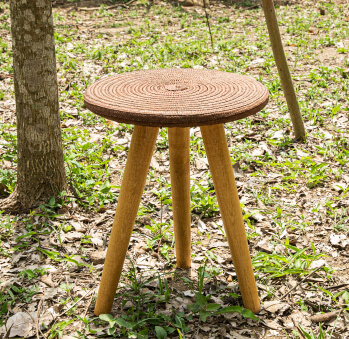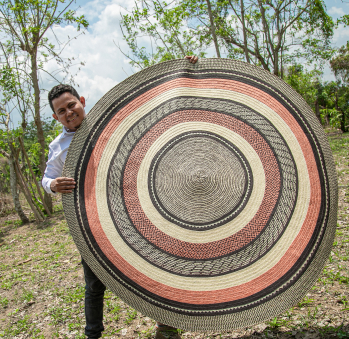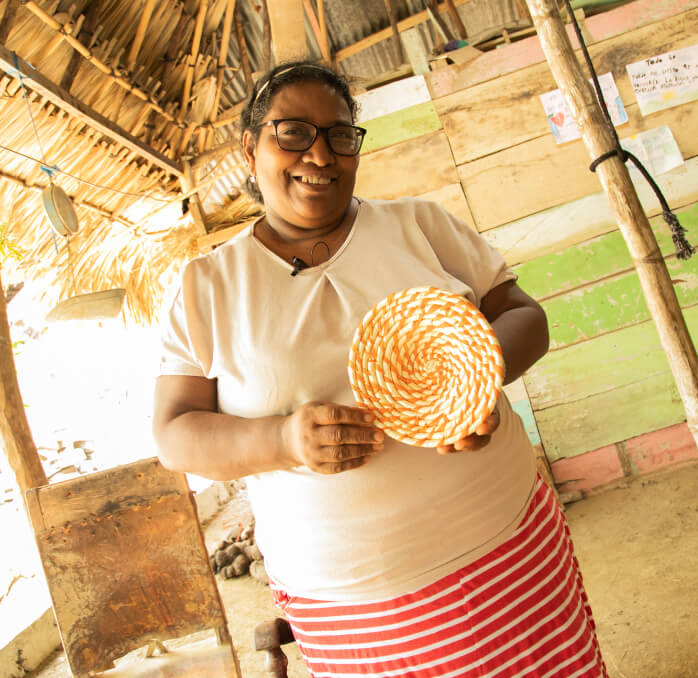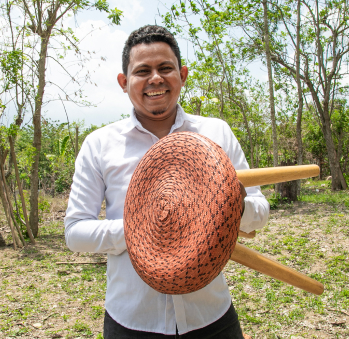Víctor Otero y Elida Polo
Workshop: Caña flecha
Craft: Tejeduría
Trail: Sucre Route
Location: Sampués, Sucre
The Otero family is a family of artisans. Although Élida Polo, the mother, did not inherit knowledge about her craft, she passed it on to her children. She also used the profits to support her husband, Augusto Rafael Otero, in his craft of woodworking. With her, a family tradition began.
At the age of twenty, she joined a cooperative of 24 women who were taught about caña flecha by Carmen Cruz, a loving and challenging teacher. To work with this fiber, used to make sombreros vueltiaos, they had to learn the entire process after picking and washing. First, the ripping stage involved dividing the leaf from the cane into thin and even strips. Then came the dyeing process, traditionally done with mud for black hues and bija, a local vine, for red hues. Nowadays, anilines are also used to create more vibrant and assorted colors. The third step was braiding, typically done with 11, 15, 19, or 21 pairs of strips. Within these braids, pintas were made, traditional designs inspired by the region’s flora and fauna. The final step was sewing, in which Élida Polo excelled. Carmen Cruz taught her to sew straight and focus on the finishing details, ensuring that mats were flat and not wavy, which depended on the sewing quality.
Over the next decade, many events unfolded. Élida became the cooperative’s leader, had her first son, Víctor, and then, during her second pregnancy, distanced herself from the group. She became a community mother in her town, Sampués, caring for children aged 2 to 4. When she returned to her craft, she did so alone. She recalls using part of the governmental subsidies she received to buy raw materials for making bags. Selling the bags allowed her to invest in more raw materials, and to help her husband, Augusto, equip his woodworking workshop, where one of their four children, Gildardo José Otero Polo, now follows in his father’s footsteps.
In 2007, when Víctor was a teenager, he accompanied his mother to Expoartesanías, in Bogotá, for the first time. Élida had previously participated in fairs with her mats, cushions, and curtains, but this time, days went by without a single sale. While Víctor felt desperate, his mother remained confident. All the mats were still hanging at the fair’s stand when bullfighter César Rincón arrived and bought them all. Up until then, Víctor had only helped sell products on Sampués’ main avenue, which was a must-see for travelers due to its many craft stores. However, witnessing the positive reception of his mother’s work piqued his interest. He studied Systems Engineering, but would rather join her mother at the fairies. For him, anyone who chose to learn this craft should be driven by love, not obligation. The blends of braids his mother sewed fascinated him and motivated him to learn how to use a sewing machine.
Víctor and Élida have been working together ever since. When an order arrives, Élida has the final say in whether they can fulfill it, while Víctor handles the design process. He combines various pintas and braids and experiments with the sewing machine until they’re satisfied with the product. They’re joined by Elizabeth Otero, Víctor’s aunt, who is also a skilled sewer. They’ve also partnered with over ten families in town who work on the preliminary steps, such as picking, ripping, dyeing, and braiding.
In their workshop, teamwork prevails. Years of experience have taught them how to understand their customers’ preferences. An example of this is a side table they developed with the help of designer Samuel Negrete from Artesanías de Colombia, combining the talents of the Otero Polo family: caña flecha weaving and woodworking. During Expoartesanías, they noticed people trying to sit on their three-legged side tables, using them as chairs instead of tables. This led them to design a chair that addresses other of their customers’ needs: disassemblable legs to ease transportation.
Élida has passed down her tradition not only to her children but to many students across Sucre. She is the type of teacher Carmen Cruz was to her. Between 2012 and 2017, she worked as a caña flecha instructor with El Sena. She traveled to neighboring villages such as La Bomba, Corozal, Pileta, El Mamón, La Unión, Ovejas, and even Sincelejo’s penitentiary, La Vega. Many of her students embraced this craft. Following his mother’s spirit, Víctor welcomes anyone interested in learning. He even lets his six-year-old child, Zabdiel, participate in workshop activities, nurturing a love for the craft, just as it blossomed in Víctor when he was sixteen. Recently, Víctor’s sister, Elis Lizeth Otero, who had previously shown no interest in crafts, became engaged after being asked to help sell at the Artisanal Fair of Pitalito, Huila. Thus, step by step and without coercion, they’ve been persuading more people to learn about working with caña flecha fibers, keeping this tradition alive.
Craft














Artisans along the way
Artisans along the way
No puede copiar contenido de esta página



























































